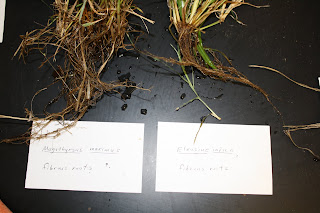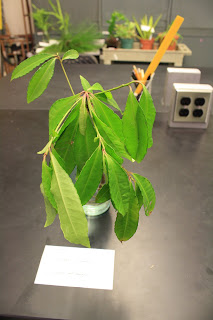The lab had examples of:
I. Duration: we did not have examples of "duration" in class but you can think about seasonality and how is that related to plants, do all plants come back after the winter?
II. Roots function as an anchorage, absorption and storage organ for the plant. These are different examples of roots that you observed in the lab.
A. Taproots
Sida rhombifolia
Daucus carota
B. Fibrous roots
Megathyrsus maximus (left) & Eleusine indica (right)
In this specimen you were able to see two root types: fibrous and adventitious
Stenotaphrum secundatum
C.Adventitious roots
Try to enlarge this picture in your browser and check the roots of this small leafless orchid, do you notice that they are photosynthetic? (green)
Dendrophylax porrectus
Clusia sp.
Phyla nodiflora
D.Aerial roots
Tillandsia recurvata
Special example: Ipomoea batatas (this is an example of tuberous roots)
III. Stems: they can be aerial or subterranean and divided into nodes, the points at which leaves are borne, and internodes, the areas between the nodes.
A. Rhizomes
Stenotaphrum secundatum
B. Tubers
Solanum tuberosum
C. Corms
Colocasia esculenta, besides the corm, this species also shows rhizomes
D. Bulbs
Allium cepa
Important questions: Where are the carbohydrates stored in a corm? bulb?
E.What is the difference between thorns, spines and prickles? What is the function/s of these structures?
Thornes
Citrus trifoliata
Spines- note the green fleshy stem
Opuntia
Prickles
Rubus cuneifolius
V. Leaves: they function as photosynthetic organs, generally broad and/or flattened and borne at the nodes of a stem. In flowerng plants just above the point of attachment of the leaf base or petiole there is an axillary bud.
A. Leaf arrangement.
Alternate leaves
Prunus caroliniana
Opposite leaves
Viburnum odoratissimum
Whorled
Nerium oleander
Clerodendrum indicum
B. Parts and features of leaves
Identify parts of a leaf, leaf venation, leaf margins, apex and base of leaves: In this part of the lab you were asked to identify the following structures in different plant species, you need to be able to distinguish:
Parts:
1. pulvinus
2. petiole
3. blade
4. stipules
5. leaf axil
6. adaxial and abaxial surfaces
7. compound vs. simple leaf
8. pinnately vs. palmately compound leaf
9. A sessile leaf
We recommend you to use all these pictures to review all of the terms mentioned above
Cercis canadensis
Check the large stipules present in this plant
Dombeya x cayeuxi
This specimen has pinnately compound leaves
Carya glabra
Contrast the previous specimen with this one that has palmately compound leaves
Casimiroa edulis
This plant has unifoliolate leaves, this is an example of a compound leaf that has been reduced to a single leaflet, observe carefully the base of the leaf.
Citrus aurantiaca
This is an example of sessile leaves
Eucalyptus sp.
Types of leaf venation:
1. Parallel - most of the monocots have parallel leaves
2. pinnate
Carpinus caroliniana
3. Palmate
Liquidambar styraciflua
Leaf variation: the following section tries to show you the diversity of leaf forms. As an exercise try to describe them using the appropriate botanical terms, and make sure that you can identify if leaves are simple, compound, types of margins, shapes of the base and apex. Remember to look at both sides of the leaves (abaxial and adaxial), since some important identification features can be located on one side of the leaf only (hairs, domatia, pellucid dots, etc).
This is an example of lobed leaves, look at the shape, apex, base, venation
Liriodendron tulipifera
The abaxial side of this leaf is white, in botanical/latin terms this is called "glaucus"
Acer rubrum
Look at these pinnately compound leaves
Look at these pinnately compound leaves
Sapindus emarginata
Check the leaf variation within the same individual
Quercus hemisphaerica
Quercus nigra
Ardisia crenata
Pinnately compound leaves
Pistacia chinensis
Quercus
How many times compound?
Nandina domestica
Delonix regia
Elaeagnus pungens
These are some examples of modified leaves
Echeveria imbricata
Nepenthes
Agave






























































thanks for taking the trouble to do this. it has me helped a lot with my RHS exam revision
ReplyDelete